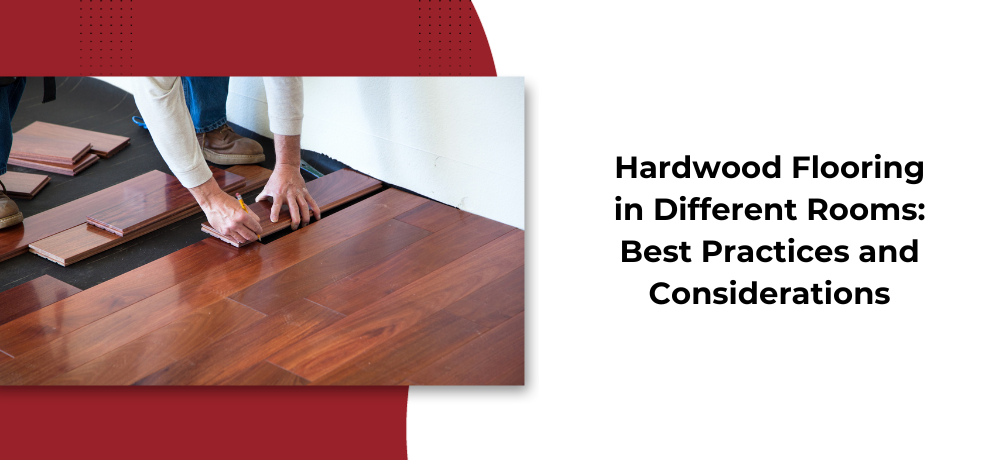Hardwood Flooring in Different Rooms: Best Practices and Considerations

When it comes to selecting the right flooring for your home, hardwood flooring is a timeless and versatile choice that can add elegance and warmth to any space. Whether you're planning to install hardwood flooring in your living room, bedroom, kitchen, or any other room in your home, there are several best practices and considerations to keep in mind. In this comprehensive guide, we'll explore the various aspects of using hardwood flooring in different rooms, offering insights into design, maintenance, and functionality.
Choosing the Right Hardwood Flooring
Hardwood Flooring Types
Before diving into room-specific considerations, it's essential to understand the different types of hardwood flooring available. The choice of hardwood species, plank width, and finish can significantly impact the overall aesthetic of your space. Here are some common hardwood flooring types:
Solid Hardwood Flooring
Solid hardwood flooring is made from a single piece of wood and offers a classic and authentic look. It's available in various species, including oak, maple, cherry, and more. Solid hardwood is an excellent choice for living rooms, dining areas, and bedrooms.
Engineered Hardwood Flooring
Engineered hardwood consists of multiple layers of wood, with a top layer of real hardwood. It's more stable and resistant to moisture, making it suitable for kitchens and basements. Additionally, engineered hardwood is versatile and can be installed in various rooms.
Exotic Hardwood Flooring
Exotic hardwoods like Brazilian cherry or teak provide a unique and luxurious look. These woods are often harder and more durable than domestic species, making them ideal for high-traffic areas.
Hardwood Flooring Finishes
The finish of your hardwood flooring not only affects its appearance but also its durability and maintenance requirements. Common finishes include:
Oil-Based Finish
Oil-based finishes offer a traditional, warm appearance and are suitable for low-traffic areas. They require periodic reapplication for maintenance.
Water-Based Finish
Water-based finishes provide a clear, contemporary look and are more environmentally friendly. They are ideal for high-traffic areas and are easier to maintain.
Hardwood Flooring Colors and Stains
The color of your hardwood flooring can greatly impact the ambiance of a room. Lighter colors can make a space feel more open and airy, while darker tones create a cozy and intimate atmosphere. Stains can also be applied to enhance or alter the natural color of the wood.
Best Practices for Different Rooms
Now that you have a grasp of the basics, let's delve into the specific considerations for different rooms in your home.
Living Room
The living room is often the heart of the home, where families gather and entertain guests. When using hardwood flooring in the living room, consider the following:
Furniture and Layout
Choose furniture that complements the hardwood flooring. Area rugs can define spaces and protect high-traffic areas. Ensure the layout allows for a harmonious flow within the room.
Maintenance
Regularly clean and maintain the hardwood to prevent scratches and scuffs. Consider using furniture pads to protect the flooring under heavy pieces.
Styling
Use the living room's design to create a warm and inviting ambiance. Hardwood flooring pairs well with a variety of styles, from traditional to modern.
Bedroom
Hardwood flooring in the bedroom can create a cozy and tranquil retreat. Here are some considerations:
Area Rugs
Place area rugs or runners alongside the bed to add warmth and comfort underfoot. This also adds a decorative element to the room.
Underfloor Heating
Consider underfloor heating to keep the bedroom comfortable during colder months. Hardwood is a great conductor of heat, ensuring your room stays cozy.
Soundproofing
To minimize noise, especially in multi-story homes, you can opt for an acoustic underlayment beneath the hardwood flooring.
Kitchen
Kitchens require durable and water-resistant flooring options. When using hardwood in the kitchen:
Finish Selection
Choose a water-resistant finish to protect against spills and splashes. Wipe up spills promptly to prevent damage to the wood.
Area Rugs
Place area rugs near the sink and food preparation areas to catch any water or food spills.
Regular Maintenance
Maintain the flooring by sweeping and mopping regularly. Reapply the finish as needed to maintain its protective properties.
Bathroom
While not the most common choice for bathrooms due to moisture concerns, hardwood can be used effectively with proper precautions:
Sealant
Apply a high-quality sealant to protect the wood from moisture. Be diligent about wiping up any water spills immediately.
Ventilation
Ensure proper bathroom ventilation to minimize humidity and moisture buildup.
Regular Inspections
Regularly check for any signs of water damage or warping. Promptly address any issues to prevent further damage.
Incorporating hardwood flooring into different rooms of your home can transform your space and elevate its aesthetic. Whether you choose solid hardwood or engineered hardwood, selecting the right type, finish, and color is crucial. Additionally, room-specific considerations, such as furniture choices and maintenance practices, play a vital role in ensuring the longevity and beauty of your hardwood floors.
For a wide range of hardwood flooring options and expert advice, then reach out to Sine's Flooring. Their expansive showroom and knowledgeable staff can help you make the best choices for your home. Make your dream space a reality with the timeless beauty of hardwood flooring.
Get in touch with us today
To learn more about what we do, please click here. To contact us, please click here or call us at (905) 372-2679.